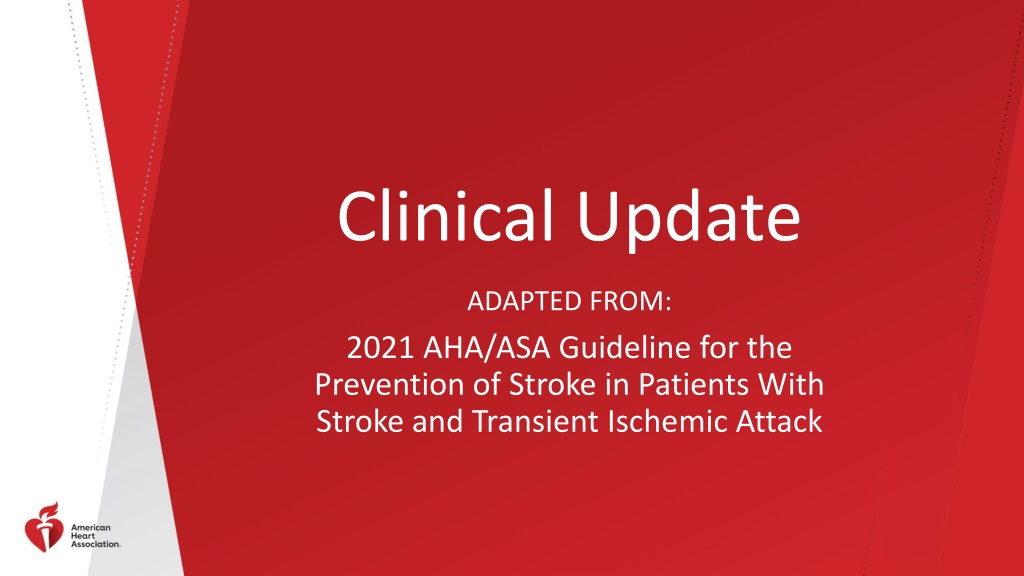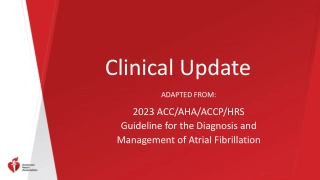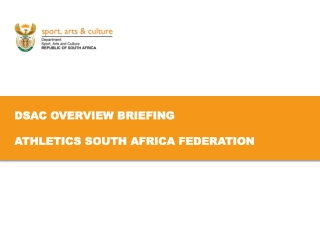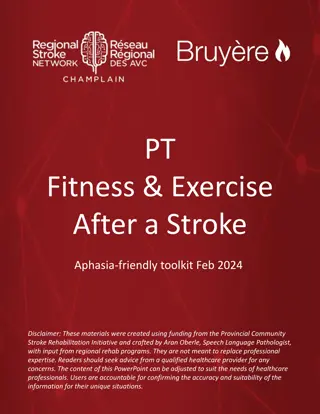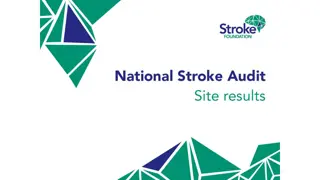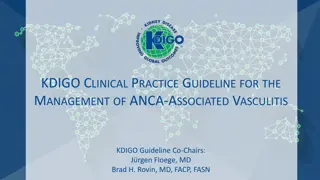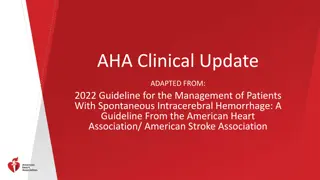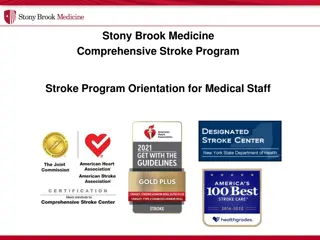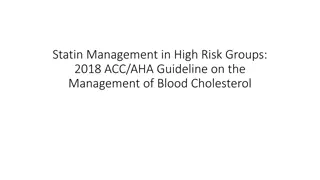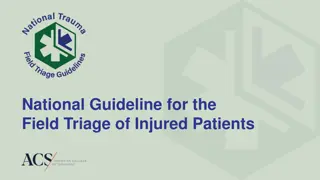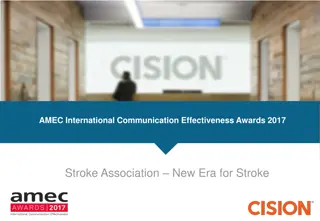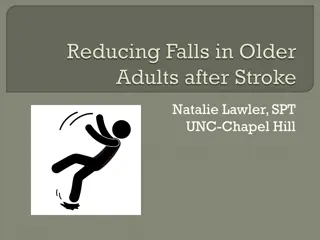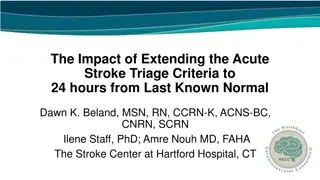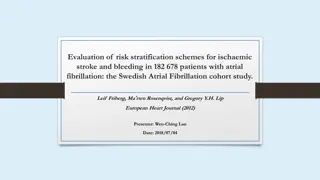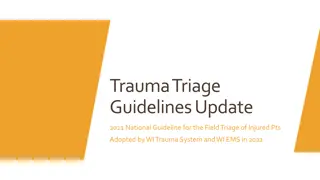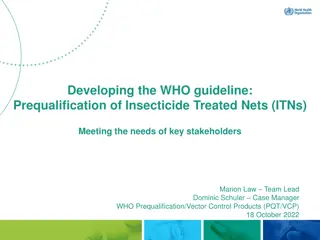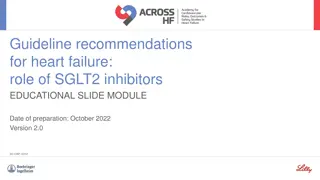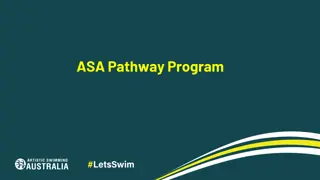Clinical Update: 2021 AHA/ASA Guideline for Stroke Prevention
This clinical update provides guidance adapted from the 2021 AHA/ASA Guideline for the Prevention of Stroke in Patients with Stroke and Transient Ischemic Attack. It categorizes recommendations based on strength and quality of evidence, outlining levels of recommendation and evidence for different clinical strategies and interventions in patient care. The update emphasizes the importance of evidence-based practices in stroke prevention and management.
Download Presentation

Please find below an Image/Link to download the presentation.
The content on the website is provided AS IS for your information and personal use only. It may not be sold, licensed, or shared on other websites without obtaining consent from the author. Download presentation by click this link. If you encounter any issues during the download, it is possible that the publisher has removed the file from their server.
E N D
Presentation Transcript
Clinical Update ADAPTED FROM: 2021 AHA/ASA Guideline for the Prevention of Stroke in Patients With Stroke and Transient Ischemic Attack
CLASS (STRENGTH) OF RECOMMENDATION LEVEL (QUALITY) OF EVIDENCE CLASS 1 (STRONG) Benefit >>> Risk LEVEL A High-quality evidence from more than 1 RCT Meta-analyses of high-quality RCTs One or more RCTs corroborated by high-quality registry studies Suggested phrases for writing recommendations: Is recommended Is indicated/useful/effective/beneficial Should be performed/administered/other Comparative-Effectiveness Phrases : Treatment/strategy A is recommended/indicated in preference to treatment B Treatment A should be chosen over treatment B LEVEL B-R (Randomized) Table 1. Applying Class of Recommendation and Level of Evidence to Clinical Strategies, Interventions, Treatments, or Diagnostic Testing in Patient Care Moderate-quality evidence from 1 or more RCTs Meta-analyses of moderate-quality RCTs LEVEL B-NR (Nonrandomized) CLASS 2a (MODERATE) Benefit >> Risk Moderate-quality evidence from 1 or more well-designed, well- executed nonrandomized studies, observational studies, or registry studies Meta-analyses of such studies Suggested phrases for writing recommendations: Is reasonable Can be useful/effective/beneficial Comparative-Effectiveness Phrases : Treatment/strategy A is probably recommended/indicated in preference to treatment B It is reasonable to choose treatment A over treatment B LEVEL C-LD (Limited Data) Randomized or nonrandomized observational or registry studies with limitations of design or execution Meta-analyses of such studies Physiological or mechanistic studies in human subjects CLASS 2b (Weak) Benefit Risk Suggested phrases for writing recommendations: May/might be reasonable May/might be considered Usefulness/effectiveness is unknown/unclear/uncertain or not well- established LEVEL C-EO (Expert Opinion) A recommendation with LOE C does not imply that the recommendation is weak. Many important clinical questions addressed in guidelines do not lend themselves to clinical trials. Although RCTs are unavailable, there may be a very clear clinical consensus that a particular test or therapy is useful or effective. COR and LOE are determined independently (any COR may be paired with any LOE). Consensus of expert opinion based on clinical experience. CLASS 3: No Benefit (MODERATE) Benefit = Risk *The outcome or result of the intervention should be specified (an improved clinical outcome or increased diagnostic accuracy or incremental prognostic information). For comparative-effectiveness recommendation (COR 1 and 2a; LOE A and B only), studies that support the use of comparator verbs should involve direct comparisons of the treatments or strategies being evaluated. Suggested phrases for writing recommendations: Is not recommended Is not indicated/useful/effective/beneficial Should not be performed/administered/other The method of assessing quality is evolving, including the application of standardized, widely-used, and preferably validated evidence grading tools; and for systematic reviews, the incorporation of an Evidence Review Committee. CLASS 3: Harm (STRONG) Risk > Benefit COR indicates Class of Recommendation; EO, expert opinion; LD, limited data; LOE, Level of Evidence; NR, nonrandomized; R, randomized; and RCT, randomized controlled trial. Suggested phrases for writing recommendations: Potentially harmful Kleindorfer, D. O., et al. (2021). 2021 AHA/ASA Guideline for the Prevention of Stroke in Patients With Stroke and Transient Ischemic Attack. Stroke. Causes harm Associated with excess morbidity/mortality Should not be performed/administered/other 2
Introduction & Scope Pillars of Prevention Annual Ischemic Stroke and TIA Incidence Recurrent Stroke 185K Blood Pressure Control Total Strokes: ~795K Diet Ischemic Strokes 690K (87%) TIA ~240K Physical Activity Smoking Cessation Guiding Principle: Secondary prevention for Stroke and TIA patients is identical! Abbreviation: TIA indicates transient ischemic attack. Kleindorfer, D. O., et al. (2021). 2021 AHA/ASA Guideline for the Prevention of Stroke in Patients With Stroke and Transient Ischemic Attack. Stroke. 3
Figure 1. Conceptual Representation of Ischemic Stroke Subtypes Intracerebral Hemorrhage Subarachnoid Hemorrhage Stroke Ischemic Stroke Lacunar (Majority due to small vessel disease) Non-Lacunar Ischemic Stroke Cardioembolic Large Artery Cryptogenic Other Non-Lacunar Stroke ESUS NON-ESUS Cryptogenic Stroke Abbreviations: ESUS indicates embolic stroke of undetermined source; and non-ESUS, non-embolic stroke of undetermined source. Kleindorfer, D. O., et al. (2021). 2021 AHA/ASA Guideline for the Prevention of Stroke in Patients With Stroke and Transient Ischemic Attack. Stroke. 4
Shared Decision-Making & Adherence Shared Decision Making Key component of patient-centered care Process in which clinicians describe options, risks, benefits and assists patients in evaluating options Collaboratively develop care plans with patients, incorporating patients wishes, goals, and concerns Assessing Barriers to Adherence Assess and address barriers to adherence to medications and lifestyle In recurrent stroke, vital to assess whether taking prescribed medications Explore and, if possible, address factors that contributed to non-adherence, prior to assuming medications were ineffective Kleindorfer, D. O., et al. (2021). 2021 AHA/ASA Guideline for the Prevention of Stroke in Patients With Stroke and Transient Ischemic Attack. Stroke. 5
Diagnostics: Test and Implications for Stroke Prevention ECG Screen for atrial fibrillation/flutter Detects additional arrhythmias Assesses for myocardial infarction Intracranial Arterial Imaging Identifies stenosis, dissection, etc. Rhythm Monitoring Mobile cardiac outpatient telemetry, implantable loop recorder, or other approach, is reasonable to detect intermittent atrial fibrillation Blood Testing Informs therapy and identifies risk factors for modification Can include testing for cryptogenic strokes if needed Echocardiography Identifies possible cardioaortic sources of or transcardiac pathways for cerebral embolism Transthoracic echocardiography is preferred over TEE for the detection of left ventricular (LV) thrombus, but TEE is superior to transthoracic echocardiogram in detecting left atrial thrombus, aortic atheroma, prosthetic valve abnormalities, native valve abnormalities, atrial septal abnormalities, and cardiac tumors CT or MRI Brain Imaging Confirms ischemic cause of symptoms May need repeat imaging after thrombolysis or to confirm diagnosis Cervical Carotid Imaging Utilized to screen for stenosis, dissection, etc. Types of diagnostic testing approaches include carotid ultrasound, CTA, and MRA ultrasonography, CTA), or magnetic CT angiography (CTA), or magnetic resonance angiography (MRA) is Abbreviations: CT, indicates computed tomography; ; CTA, computerized tomography angiography; MRA, magnetic resonance angiography; MRI, magnetic resonance imaging; and TEE, transesophageal echocardiography. Kleindorfer, D. O., et al. (2021). 2021 AHA/ASA Guideline for the Prevention of Stroke in Patients With Stroke and Transient Ischemic Attack. Stroke. recommended to screen for stenosis.4arotid ultrasonography, CT 6
Figure 2. Algorithm for Evaluating Patients with Clinical Diagnosis of Stroke for Optimizing Prevention of Recurrent Ischemic Stroke NO CT or MRI (Class 1) Consider delayed reimaging with CT or MRI if not done initially (Class 2a) Shows ischemic stroke CT or MRI shows ischemic stroke mimic NO YES Manage accordingly YES Echocardiography to evaluate for cardiac SOE (Class 2a) ECG and basic laboratory tests* (Class 1) NO YES Anterior circulation infarct Non-invasive intracranial and extracranial imaging of vertebrobasilar arterial system (Class 2a) Non-invasive cervical carotid imaging [CTA, MRA, or US] (Class 1) Non-invasive intracranial arterial imaging (Class 2a) Long-term cardiac rhythm monitoring (Class 2a) Based on age, medical comorbidities and clinical syndrome, consider: Test for genetic stroke syndrome (Class 2a) YES NO Manage accordingly Cause identified Test for infectious vasculitis (Class 2a) TEE, Cardiac CT or Cardiac MRI (Class 2b) Evaluate for other rare causes of stroke Abbreviations: CT indicates computed tomography; CTA, computed tomography angiogram; ECG, electrocardiogram; MRA, magnetic resonance angiography; MRI, magnetic resonance imaging; SOE, source of embolism; TEE, transesophageal echo; TIA; transient ischemic attack: and US, ultrasound. When a patient has a transient neurological deficit clinically characteristic of transient ischemic attack, the patient should be evaluated in the same manner as a patient who has an ischemic stroke with a corresponding cerebral infarct on imaging. Kleindorfer, D. O., et al. (2021). 2021 AHA/ASA Guideline for the Prevention of Stroke in Patients With Stroke and Transient Ischemic Attack. Stroke. 7
Vascular Risk Factor Management: Nutrition + hypertension Stroke or transient ischemic attack (if not currently restricting dietary sodium) Mediterranean type diet (in preference to low-fat diet) (Class 2a) In patients with stroke or TIA and hypertension who are not currently restricting their dietary sodium intake, it is reasonable to recommend that individuals reduce their sodium intake by at least 1g/d sodium (2.5 grams/day salt) to reduce the risk of cardiovascular disease (CVD) events (including stroke) (Class 2a) Mediterranean Diet (Summarized) High monounsaturated/saturated fat ratio (use of olive oil as main cooking ingredient and/or consumption of other traditional foods high in monounsaturated fats such as tree nuts) High intake of plant based foods, including fruits, vegetables and legumes High consumption of whole grains and cereals Increased consumption of fish Low consumption of meat and meat products Discourages red and processed meats Low to moderate red wine consumption Moderate consumption of milk and dairy products Reduced risk of cardiovascular disease events (including stroke) Discourages soda drinks, pastries, sweets, commercial bakery products and spread fats Reduced risk of recurrent stroke Kleindorfer, D. O., et al. (2021). 2021 AHA/ASA Guideline for the Prevention of Stroke in Patients With Stroke and Transient Ischemic Attack. Stroke. 8
Vascular Risk Factor Management: Physical Activity PATIENT POPULATION COR RECOMMENDATIONS IMPACT Moderate intensity aerobic activity for a minimum of 10 minutes 4 times a week OR Vigorous intensity aerobic activity for a minimum of 20 minutes 2 times a week Lower risk of recurrent stroke and composite cardiovascular endpoint of recurrent stroke, myocardial infarction, or vascular death Capable of physical activity 1 Reduces cardiometabolic risk factors and increases leisure time physical activity participation Able to increase physical activity Engage in exercise class that includes counseling to change physical activity behavior 2a Supervision of exercise program by health care professional (ex. physical therapist, cardiac rehabilitation professional) in addition to routine rehabilitation Impaired ability to exercise 2a Beneficial for secondary stroke prevention Break up sedentary time with intervals as short as 3 minutes of standing OR light exercise every 30 minutes Sit for long periods of uninterrupted time 2b Improves cardiovascular health Kleindorfer, D. O., et al. (2021). 2021 AHA/ASA Guideline for the Prevention of Stroke in Patients With Stroke and Transient Ischemic Attack. Stroke. 9
Vascular Risk Factor Management: Smoking Cessation and Substance Use Tobacco Alcohol Counsel eliminate or reduce consumption of alcohol to reduce stroke risk (Class 1) If consumption: Current smoker Environmental (passive) exposure Men: >2 alcoholic drinks per day Women: >1 alcoholic drink per day Stimulant use Counsel stop smoking drug therapy* (or reduce use if unable to) (Class 1) Avoid exposure (Class 1) Stimulant use or Counsel behavior is health risk and to stop use (Class 1) patients with infective endocarditis (with intravenous drug use) i.e., amphetamines, amphetamine derivatives, cocaine, or khat Reduces risk of recurrent stroke Substance use *Nicotine replacement, bupropion, varenicline Specialized services to help manage dependency (Class 1) Substance use disorders (drugs and/or alcohol) Kleindorfer, D. O., et al. (2021). 2021 AHA/ASA Guideline for the Prevention of Stroke in Patients With Stroke and Transient Ischemic Attack. Stroke. 10
Vascular Risk Factor Management: Hypertension Stroke or transient ischemic attack History of hypertension? YES NO In patients with no history of hypertension who experience a stroke or TIA and have an average office BP of 130/80 mmHg, antihypertensive medication treatment can be beneficial to reduce the risk of recurrent stroke, ICH, and other vascular events (Class 2a) In patients with hypertension who experience a stroke or TIA, an office BP goal of <130/80 mmHg is recommended for most patients to reduce the risk of recurrent events and vascular stroke (Class 1) In patients with hypertension who experience a stroke or TIA, treatment with a thiazide diuretic, angiotensin-converting enzyme inhibitor, or angiotensin II receptor blockers is useful for lowering BP and reducing recurrent stroke risk (Class 1) In patients with hypertension who experience a stroke or TIA, individualized drug regimens that take into account patient comorbidities, agent pharmacological class, and patient preference are recommended to maximize drug efficacy (Class 1) Abbreviations: BP indicates blood pressure; ICH; intracranial hemorrhage; mm/Hg; millimeters of mercury; and TIA, transient ischemic attack. Kleindorfer, D. O., et al. (2021). 2021 AHA/ASA Guideline for the Prevention of Stroke in Patients With Stroke and Transient Ischemic Attack. Stroke. 11
Vascular Risk Factor Management: Hyperlipidemia and Hypertriglyceridemia HYPERLIPIDEMIA COR RECOMMENDATIONS In patients with ischemic stroke with no known coronary heart disease, no major cardiac sources of embolism, and LDL cholesterol (LDL-C) >100 mg/dL, atorvastatin 80 mg daily is indicated to reduce risk of stroke recurrence 1 In patients with ischemic stroke or TIA and atherosclerotic disease (intracranial, carotid, aortic, or coronary), lipid- lowering therapy with a statin and also ezetimibe, if needed, to a goal LDL-C of <70 mg/dL is recommended to reduce the risk of major cardiovascular events 1 In patients with ischemic stroke who are very high risk (defined as stroke plus another major ASCVD or stroke plus multiple high-risk conditions), are taking maximally tolerated statin and ezetimibe therapy and still have an LDL-C >70 mg/dL, it is reasonable to treat with PCSK9 inhibitor therapy to prevent ASCVD events 2a *Stroke plus another major ASCVD or stroke plus multiple high-risk conditions In patients with stroke or TIA and hyperlipidemia, patients adherence to changes in lifestyle and the effects of LDL-C lowering medication should be assessed by measurement of fasting lipids and appropriate safety indicators 4-12 weeks after statin initiation or dose adjustment and every 3-12 months thereafter, based on need to assess adherence of safety 1 Monitoring Abbreviations: AF indicates atrial fibrillation; ASCVD, atherosclerotic cardiovascular disease; HbA1c, glycated hemoglobin A1c; LDL-C, low-density lipoprotein cholesterol; PCSK9, proprotein convertase subtilisin/kexin type 9; and TIA, transient ischemic attack. Kleindorfer, D. O., et al. (2021). 2021 AHA/ASA Guideline for the Prevention of Stroke in Patients With Stroke and Transient Ischemic Attack. Stroke. 12
Vascular Risk Factor Management: Hyperlipidemia and Hypertriglyceridemia HYPERTRIGLYCERIDEMIA COR RECOMMENDATIONS In patients with ischemic stroke or TIA, with fasting triglycerides 135 to 499 mg/dL and LDL-C of 41 to 100 mg/dL, on moderate- or high-intensity statin therapy, with HbA1c <10%, and with no history of pancreatitis, AF, or severe heart failure, treatment with icosapent ethyl (IPE) 2 g twice a day is reasonable to reduce risk of recurrent stroke. 2a In patients with severe hypertriglyceridemia (ie, fasting triglycerides 500 mg/dL [ 5.7 mmol/L]), it is reasonable to identify and address causes of hypertriglyceridemia and, if triglycerides are persistently elevated or increasing, to further reduce triglycerides in order to lower the risk of ASCVD events by implementation of a very low-fat diet, avoidance of refined carbohydrates and alcohol, consumption of omega-3 fatty acids, and, if necessary to prevent acute pancreatitis, fibrate therapy. 2a Abbreviations: AF indicates atrial fibrillation; ASCVD, atherosclerotic cardiovascular disease; HbA1c, glycated hemoglobin A1c; LDL-C, low-density lipoprotein cholesterol; and TIA, transient ischemic attack. Kleindorfer, D. O., et al. (2021). 2021 AHA/ASA Guideline for the Prevention of Stroke in Patients With Stroke and Transient Ischemic Attack. Stroke. 13
Vascular Risk Factor Management: Glucose DIABETES & ISCHEMIC STROKE OR TIA PRE-DIABETES & ISCHEMIC STROKE OR TIA COR RECOMMENDATIONS COR RECOMMENDATIONS Goal for glycemic control individualized based on risk for adverse events, patient characteristics, and preferences. Lifestyle optimization (i.e., healthy diet, regular physical activity, and smoking cessation) can be beneficial to prevent progression to diabetes. 1 2a For most patients, especially if <65 years old without life-limiting comorbid illness, achieving a goal of HbA1c 7% to reduce risk of microvascular complications. 1 If body mass index 35 kg/m2 , aged <60 years old, or women with a history of gestational diabetes, metformin may be beneficial to control blood sugar and prevent progression to diabetes. 2b Treatment of diabetes should include glucose-lowering agents with proven cardiovascular benefit to reduce the risk for future major adverse cardiovascular events (i.e., stroke, MI, cardiovascular death). 1 Multidimensional care is indicated to achieve glycemic goals and improve stroke risk factors: Lifestyle counseling Medical nutritional therapy Diabetes self-management education Support Medication 1 Usefulness of achieving intense glucose control (i.e., HbA1c 7%) beyond acute phase of ischemic event for prevention of recurrent stroke is unknown. 2b Abbreviations: HbA1c indicates glycated hemoglobin A1c; MI, myocardial infarction; and TIA, transient ischemic attack. Kleindorfer, D. O., et al. (2021). 2021 AHA/ASA Guideline for the Prevention of Stroke in Patients With Stroke and Transient Ischemic Attack. Stroke. 14
Vascular Risk Factor Management: Glucose ISCHEMIC STROKE OR TIA & UNKNOWN IF DIABETES COR RECOMMENDATIONS 2a Reasonable to screen for prediabetes / diabetes using HbA1c. 6 MONTHS AFTER ISCHEMIC STROKE OR TIA WITH INSULIN RESISTANCE, HBA1C < 7%, AND WITHOUT HEART FAILURE OR BLADDER CANCER COR RECOMMENDATIONS 2b Pioglitazone may be considered to prevent recurrent stroke. Abbreviations: HbA1c indicates glycated hemoglobin A1c; and TIA, transient ischemic attack . Kleindorfer, D. O., et al. (2021). 2021 AHA/ASA Guideline for the Prevention of Stroke in Patients With Stroke and Transient Ischemic Attack. Stroke. 15
Vascular Risk Factor Management: Obesity and Obstructive Sleep Apnea OBSTRUCTIVE SLEEP APNEA OBESITY PATIENT POPULATION PATIENT POPULATION COR RECOMMENDATIONS COR RECOMMENDATIONS Treatment with positive airway pressure (i.e., continuous positive airway pressure) can be beneficial for improved sleep apnea, blood pressure, sleepiness, and other apnea- related outcomes Ischemic stroke or TIA and overweight or obese Weight loss to improve ASCVD risk factor profile 1 Ischemic stroke or TIA and OSA 2a To achieve sustained weight loss, referral to intensive, multicomponent, behavioral lifestyle-modification program Ischemic stroke or TIA and obese 1 Evaluation for OSA may be considered for diagnosing sleep apnea Ischemic stroke or TIA 2b Calculate body mass index at time of the event and annually thereafter to screen for and classify obesity Ischemic stroke or ASCVD 1 Abbreviations: ASCVD indicates atherosclerotic cardiovascular disease; OSA, obstructive sleep apnea; and TIA, transient ischemic attack. Kleindorfer, D. O., et al. (2021). 2021 AHA/ASA Guideline for the Prevention of Stroke in Patients With Stroke and Transient Ischemic Attack. Stroke. 16
Management of Intracranial Large Artery Atherosclerosis COR RECOMMENDATIONS Antithrombotic Therapy 1. In patients with a stroke or TIA caused by 50% to 99% stenosis of a major intracranial artery, aspirin 325 mg/d is recommended in preference to warfarin to reduce the risk of recurrent ischemic stroke and vascular death. 1 2. In patients with recent stroke or TIA (within 30 days) attributable to severe stenosis (70% 99%) of a major intracranial artery, the addition of clopidogrel 75 mg/d to aspirin for up to 90 days is reasonable to further reduce recurrent stroke risk. 2a 3. In patients with recent (within 24 hours) minor stroke or high-risk TIA and concomitant ipsilateral >30% stenosis of a major intracranial artery, the addition of ticagrelor 90 mg twice a day to aspirin for up to 30 days might be considered to further reduce recurrent stroke risk. 2b 4. In patients with stroke or TIA attributable to 50% to 99% stenosis of a major intracranial artery, the addition of cilostazol 200 mg/day to aspirin or clopidogrel might be considered to reduce recurrent stroke risk. 2b 5. In patients with stroke or TIA attributable to 50% to 99% stenosis of a major intracranial artery, the usefulness of clopidogrel alone, the combination of aspirin and dipyridamole, ticagrelor alone, or cilostazol alone for secondary stroke prevention is not well established. 2b Abbreviations: TIA indicates transient ischemic attack. Kleindorfer, D. O., et al. (2021). 2021 AHA/ASA Guideline for the Prevention of Stroke in Patients With Stroke and Transient Ischemic Attack. Stroke. 17
Management of Extracranial Large Artery Atherosclerosis COR RECOMMENDATIONS 1. In patients with a TIA or nondisabling ischemic stroke within the past 6 months and ipsilateral severe (70% 99%) carotid artery stenosis, carotid endarterectomy (CEA) is recommended to reduce the risk of future stroke, provided that perioperative morbidity and mortality risk is estimated to be <6%. 1 2. In patients with ischemic stroke or TIA and symptomatic extracranial carotid stenosis who are scheduled for carotid artery stenting (CAS) or CEA, procedures should be performed by operators with established periprocedural stroke and mortality rates of <6% to reduce the risk of surgical adverse events. 1 3. In patients with carotid artery stenosis and a TIA or stroke, intensive medical therapy, with antiplatelet therapy, lipid-lowering therapy, and treatment of hypertension, is recommended to reduce stroke risk. 1 4. In patients with recent TIA or ischemic stroke and ipsilateral moderate (50% 69%) carotid stenosis as documented by catheter- based imaging or noninvasive imaging, CEA is recommended to reduce the risk of future stroke, depending on patient-specific factors such as age, sex, and comorbidities, if the perioperative morbidity and mortality risk is estimated to be <6%. 1 5. In patients 70 years of age with stroke or TIA in whom carotid revascularization is being considered, it is reasonable to select CEA over CAS to reduce the periprocedural stroke rate. 2a 6. In patients in whom revascularization is planned within 1 week of the index stroke, it is reasonable to choose CEA over CAS to reduce the periprocedural stroke rate. 2a Abbreviations: CAS indicates carotid artery stenting; CEA, carotid endarterectomy; and TIA, transient ischemic attack. Kleindorfer, D. O., et al. (2021). 2021 AHA/ASA Guideline for the Prevention of Stroke in Patients With Stroke and Transient Ischemic Attack. Stroke. 18
Continued .. Management of Extracranial Large Artery Atherosclerosis COR RECOMMENDATIONS 7. In patients with TIA or nondisabling stroke, when revascularization is indicated, it is reasonable to perform the procedure within 2 weeks of the index event rather than delay surgery to increase the likelihood of stroke free outcome. 2a 8. In patients with symptomatic severe stenosis ( 70%) in whom anatomic or medical conditions are present that increase the risk for surgery (such as radiation-induced stenosis or restenosis after CEA) it is reasonable to choose CAS to reduce the periprocedural complication rate. 2a 9. In symptomatic patients at average or low risk of complications associated with endovascular intervention, when the internal carotid artery stenosis is 70% by noninvasive imaging or >50% by catheter-based imaging and the anticipated rate of periprocedural stroke or death is >6 %, CAS may be considered as an alternative to CEA for stroke prevention, particularly in patients with significant cardiovascular comorbidities predisposing to cardiovascular complications with endarterectomy. 2b 10. In patients with a recent stroke or TIA (past 6 months), the usefulness of transcarotid artery revascularization (TCAR) for prevention of recurrent stroke and TIA is uncertain. 2b 11. In patients with recent TIA or ischemic stroke and when the degree of stenosis is <50%, revascularization with CEA or CAS to reduce the risk of future stroke is not recommended. 3: No Benefit 12. In patients with a recent (within 120 days) TIA or ischemic stroke ipsilateral to atherosclerotic stenosis or occlusion of the middle cerebral or carotid artery, extracranial intracranial bypass surgery is not recommended. 3: No Benefit Abbreviations: CAS indicates carotid artery stenting; CEA, carotid endarterectomy; and TIA, transient ischemic attack. Kleindorfer, D. O., et al. (2021). 2021 AHA/ASA Guideline for the Prevention of Stroke in Patients With Stroke and Transient Ischemic Attack. Stroke. 19
Overall Stroke Risk Reduction Strategies For Symptomatic Intracranial Atherosclerosis Intensive medical therapy Anti-platelet therapy High intensity statin Blood pressure control Physical activity (Class 1) For Symptomatic Extracranial Vertebral Atherosclerosis For Symptomatic Extracranial Atherosclerosis For Symptomatic Aortic Arch Atherosclerosis Kleindorfer, D. O., et al. (2021). 2021 AHA/ASA Guideline for the Prevention of Stroke in Patients With Stroke and Transient Ischemic Attack. Stroke. 20
Recommendations Symptomatic Moyamoya Disease Surgical revascularization with direct or indirect extracranial to intracranial bypass can be beneficial to prevent recurrent ischemic stroke or TIA (Class 2a) Anti-platelet therapy may be reasonable to prevent recurrent ischemic stroke or TIA (Class 2b) Abbreviations: TIA indicates transient ischemic attack. Kleindorfer, D. O., et al. (2021). 2021 AHA/ASA Guideline for the Prevention of Stroke in Patients With Stroke and Transient Ischemic Attack. Stroke. 21
Ischemic Stroke Due to Cerebral Small Vessel Disease Small Vessel Stroke The usefulness of cilostazol for secondary stroke prevention is uncertain (Class 2b) Kleindorfer, D. O., et al. (2021). 2021 AHA/ASA Guideline for the Prevention of Stroke in Patients With Stroke and Transient Ischemic Attack. Stroke. 22
Timing of Anticoagulation after Stroke or TIA DAY 0 Ischemic stroke or TIA DAY 0-2 TIA and non-valvular atrial fibrillation (Class 2a) DAY 2 DAY 14 DAY 14 AND ON Stroke and atrial fibrillation (low risk for hemorrhagic conversion) (Class 2b) Stroke and atrial fibrillation (HIGH risk for hemorrhagic conversion*) (Class 2a) *Large cerebral infarcts (NIHSS>15, lesions involving complete arterial territory or more than one arterial territory), evidence of hemorrhage on neuroimaging, or other features which place patient at increased risk of hemorrhagic conversion following acute stroke. Abbreviation: TIA indicates transient ischemic attack. Kleindorfer, D. O., et al. (2021). 2021 AHA/ASA Guideline for the Prevention of Stroke in Patients With Stroke and Transient Ischemic Attack. Stroke. 23
Figure 3. Antithrombotic Regimen in Ischemic Stroke or TIA and Different Valvular Heart Disease Conditions Valvular Heart Disease and Ischemic Stroke or TIAs Atrial Fibrillation Sinus Rhythm Infective Endocarditis Moderate- Severe MS or Mechanical Valve* MV/AV Bioprosthesis Mechanical MV/AV Intracranial Hemorrhage or Major Ischemic Stroke Non- AVD All Other VHD Conditions Rheumatic MVD NO YES Warfarin (Class 1) DOAC (Class 1) Antiplatelet (Class 1) Warfarin (Class 1) Delay Surgery (Class 2b) Recurrent Embolic Stroke Despite Abx therapy Mobile Recurrent Stroke/TIA? *Definition of Valvular AF Includes MAC and MVP Rheumatic and Non-Rheumatic AVD Increase the target INR by 0.5 depending on bleeding risk. Abbreviations: Abx indicates antibiotics; AF, atrial fibrillation; AV, aortic valve; AVD, aortic valve disease; DOAC, direct oral anticoagulant; MAC, mitral annular calcification; MS, mitral stenosis; MV, mitral valve; MVD, mitral valve disease; MVP, mitral valve prolapse; TIA, transient ischemic attack; VHD, and valvular heart disease. Vegetation >10 mm Assess Valve Function, Rule Out Non-Valvular Causes, Assess Bleeding Risk Early Surgery (Class 2b) Early Surgery (Class 2a) Consider Intensifying Warfarin (Class 2b) Kleindorfer, D. O., et al. (2021). 2021 AHA/ASA Guideline for the Prevention of Stroke in Patients With Stroke and Transient Ischemic Attack. Stroke. 24
Secondary Stroke Prevention with Prosthetic Heart Valves Prosthetic Heart Valve and Ischemic Stroke or TIA Treatment with Dabigatran is harmful Bioprosthetic MV/AV Mechanical MV/AV Mechanical AV Mechanical MV Stroke or TIA BEFORE valve placement (and no other reason for AC beyond 3-6 months of valve placement) Stroke or TIA with aortic valve in place Stroke or TIA BEFORE valve placement Higher intensity Warfarin to INR 3.0 (range 2.5-3.5) OR Add Aspirin (75-100mg/d) (Class 2a) Warfarin INR target 3.0 (range 2.5-3.5) AND Aspirin (75-100mg/d) (Class 1) Long-Term therapy with Aspirin (Class 1) Abbreviations: AC indicates anticoagulation; AV, aortic valve; INR, international normalized ratio; MV, mitral valve; and TIA, transient ischemic attack. Kleindorfer, D. O., et al. (2021). 2021 AHA/ASA Guideline for the Prevention of Stroke in Patients With Stroke and Transient Ischemic Attack. Stroke. 25
Figure 4. Secondary Stroke Prevention in cardiomyopathy and intra-cardiac thrombus Cardiomyopathy and history of ischemic stroke/TIA in Sinus Rhythm Left ventricular or left atrial thrombus LV Non-Compaction Presence of LVAD Other Warfarin (Class 2a) Warfarin (Class 1) Warfarin + Aspirin (Class 2a) Individualized Choice (Class 2b) Abbreviations: LV indicates left ventricle; LVAD, left ventricular assist device; and TIA, transient ischemic attack. . Kleindorfer, D. O., et al. (2021). 2021 AHA/ASA Guideline for the Prevention of Stroke in Patients With Stroke and Transient Ischemic Attack. Stroke. 26
Figure 5. Secondary Stroke Prevention with PFO MRI of brain confirming ischemic stroke MRI or CT of intracranial and extracranial vessels with contrast Contrasted echocardiography or other advanced cardiac imaging Early evaluation for DVT, including lower extremity doppler and consideration of pelvic MRV Prolonged cardiac monitoring to screen for intermittent atrial fibrillation Consider toxicology screen, C-reactive protein, antiphospholipid antibodies, other labs as indicated Low threshold for blood cultures, hypercoagulable evaluation, vasculitis workup including catheter angiogram and LP, consideration of rare causes of stroke including genetic etiologies Patients age 18-60 with non-lacunar stroke and PFO Evaluation for cause by combined neurology/cardiology team Alternative etiology found? High Risk PFO PFO closure is reasonable Factors reducing potential benefit of closure: Low RoPE score, including older age and multiple risk factors Need for anticoagulation (Class 2a) NO YES YES Potential paradoxical embolism Treat underlying etiology Atrial septal aneurysm or large right-to-left shunt Low Risk PFO Benefit of PFO closure is not well established Factors increasing potential benefit of closure: High RoPE score, including young age and no risk factors History of DVT or prothrombotic condition Prior non-lacunar stroke or cortical TIA Failure of antiplatelet treatment Abbreviations: CT indicates computed tomography; DVT, deep vein thrombosis; LP, lumbar puncture; MRI, magnetic resonance imaging; MRV, magnetic resonance venography; PFO, patent foramen ovale; RoPE, Risk of Paradoxical Embolism; and TIA, transient ischemic attack. NO (Class 2b) Kleindorfer, D. O., et al. (2021). 2021 AHA/ASA Guideline for the Prevention of Stroke in Patients With Stroke and Transient Ischemic Attack. Stroke. 27
Secondary Stroke Prevention in Congenital Heart Disease Stroke or TIA of presumed cardioembolic origin with cyanotic CHD and other complex lesions Stroke or TIA and Fontan Palliation Warfarin (Class 1) Warfarin (Class 2a) Abbreviations: CHD indicates congenital heart disease; and TIA, transient ischemic attack Kleindorfer, D. O., et al. (2021). 2021 AHA/ASA Guideline for the Prevention of Stroke in Patients With Stroke and Transient Ischemic Attack. Stroke. 28
Management: Cardiac Tumors, Malignancy, and Stroke Stroke or Transient Ischemic Attack AND AND Atrial fibrillation AND Cancer Left-sided cardiac tumor Tumor resection (Class 2a) DOAC preferred over warfarin (Class 2a) Abbreviation: DOAC indicates direct acting oral anticoagulants. Kleindorfer, D. O., et al. (2021). 2021 AHA/ASA Guideline for the Prevention of Stroke in Patients With Stroke and Transient Ischemic Attack. Stroke. 29
Management: Cervical Artery Dissection Extracranial carotid OR vertebral arterial dissection AND Ischemic stroke or TIA Antithrombotic therapy for at least three months (Class 1) In patients with ischemic stroke or TIA who are <3 months after an extracranial carotid or vertebral arterial dissection, it is reasonable to use either aspirin or warfarin to prevent recurrent stroke or TIA. (Class 2a) Recurrent events despite antithrombotic therapy Sudden neck movement and cervical artery dissection John W. Norris, Vadim Beletsky, Zurab G. Nadareishvili and on behalf of the Canadian Stroke Consortium CMAJ July 11, 2000163(1) 38-40; Endovascular therapy (Class 2b) Abbreviation: TIA indicates transient ischemic attack. Kleindorfer, D. O., et al. (2021). 2021 AHA/ASA Guideline for the Prevention of Stroke in Patients With Stroke and Transient Ischemic Attack. Stroke. 30
Hypercoagulable States: Hematologic Traits COR RECOMMENDATIONS In patients with ischemic stroke or TIA of unknown source despite thorough diagnostic evaluation and no other thrombotic history who are found to have prothrombin 20210A mutation, activated protein C resistance, elevated factor VIII levels, or deficiencies of protein C, protein S, or antithrombin III, antiplatelet therapy is reasonable to reduce the risk of recurrent stroke or TIA. 2a Abbreviations: TIA indicates transient ischemic attack. Kleindorfer, D. O., et al. (2021). 2021 AHA/ASA Guideline for the Prevention of Stroke in Patients With Stroke and Transient Ischemic Attack. Stroke. 31
Hypercoagulable States: Antiphospholipid Syndrome COR LOE RECOMMENDATIONS 1. In patients with ischemic stroke or transient ischemic attack who have an isolated antiphospholipid antibody but do not fulfill the criteria for antiphospholipid syndrome, antiplatelet therapy alone is recommended to reduce the risk of recurrent stroke. 1 B-NR 2. In patients with ischemic stroke or transient ischemic attack with confirmed antiphospholipid syndrome, treated with warfarin, it is reasonable to choose a target international normalized ratio between 2-3 over a target international normalized ratio > 3 to effectively balance the risk of excessive bleeding against the risk of thrombosis. 2a B-R 3. In patients with ischemic stroke or transient ischemic attack who meet the criteria for the antiphospholipid syndrome, it is reasonable to anticoagulate with warfarin to reduce the risk of recurrent stroke or transient ischemic attack. 2a C-LD 3 4. In patients with ischemic stroke or transient ischemic attack, antiphospholipid syndrome with history of thrombosis and triple positive aPL antibodies (i.e., lupus anticoagulant, anticardiolipin and anti- beta2-glycoprotein I), rivaroxaban is not recommended because it is associated with excess thrombotic events compared to warfarin. HARM B-R Abbreviations: aPL indicates antiphospholipid. Kleindorfer, D. O., et al. (2021). 2021 AHA/ASA Guideline for the Prevention of Stroke in Patients With Stroke and Transient Ischemic Attack. Stroke. 32
Clinical Management: Hyperhomocysteinemia Elevated serum homocysteine levels have been associated with elevated risk of stroke however COR RECOMMENDATIONS 1. In patients with ischemic stroke or transient ischemic attack with hyperhomocysteinemia, supplementation with folate, vitamin B6, and vitamin B12 is not effective for preventing subsequent stroke. 3 NO BENEFIT Kleindorfer, D. O., et al. (2021). 2021 AHA/ASA Guideline for the Prevention of Stroke in Patients With Stroke and Transient Ischemic Attack. Stroke. 33
Clinical Management: Sickle Cell Disease SCD and Ischemic stroke/TIA Transfusion therapy available Transfusion therapy unavailable Chronic blood transfusion(s) to reduce hemoglobin S to <30% of total hemoglobin is recommended for the prevention of recurrent ischemic stroke (Class 1) Hydroxyurea (Class 2a) Abbreviations: Hgb indicates hemoglobin; SCD, sickle cell disease; and TIA, transient ischemic attack. Kleindorfer, D. O., et al. (2021). 2021 AHA/ASA Guideline for the Prevention of Stroke in Patients With Stroke and Transient Ischemic Attack. Stroke. 34
Recommendations for Autoimmune and Infectious Vasculitis COR RECOMMENDATIONS 1. In patients with ischemic stroke or transient ischemic attack and symptoms attributed to giant cell arteritis, immediate initiation of oral high-dose glucocorticoids is recommended to reduce recurrent stroke risk. 1 2. In patients with ischemic stroke or transient ischemic attack and diagnosis of giant cell arteritis, methotrexate or tocilizumab therapy adjunctive to steroids is reasonable to lower the risk of recurrent stroke. 2a 3. In patients with ischemic stroke or transient ischemic attack and diagnosis of primary central nervous system angiitis, induction therapy with glucocorticoids and/or immunosuppressants followed by long-term maintenance therapy with steroid-sparing immunosuppressants is reasonable to lower the risk of stroke recurrence. 4. In patients with ischemic stroke or transient ischemic attack and confirmed diagnosis of giant cell arteritis, infliximab is associated with recurrent ocular symptoms and markers of disease activity and should not be administered. 3 HARM COR RECOMMENDATIONS 1. In patients with ischemic stroke or transient ischemic attack and infectious vasculitis such as varicella zoster virus cerebral vasculitis, neurosyphilis, bacterial meningitis, treating the underlying infectious etiology is indicated to reduce the risk of stroke. 1 2. In patients with ischemic stroke or transient ischemic attack in the context of human immunodeficiency virus vasculopathy, daily aspirin plus human immunodeficiency virus viral control with combined antiretroviral therapy is reasonable to reduce risk of recurrent stroke. 2a Kleindorfer, D. O., et al. (2021). 2021 AHA/ASA Guideline for the Prevention of Stroke in Patients With Stroke and Transient Ischemic Attack. Stroke. 35
Recommendations for Genetic Disorders COR RECOMMENDATIONS 1. In patients with ischemic stroke or transient ischemic attack and cystathionine beta-synthase deficiency, pyridoxine (in responsive patients) and a low methionine, cysteine-enhanced diet supplemented with pyridoxine, vitamin B12 and folate is recommended to reduce plasma homocysteine to population normal levels and thereby reduce risk of recurrent ischemic stroke. 1 2. In patients with ischemic stroke or transient ischemic attack and Anderson-Fabry Disease, agalsidase alfa or agalsidase beta is of uncertain value in preventing recurrent stroke or TIA. 2b Recommendations for Carotid Webs COR RECOMMENDATIONS 1. In patients with carotid web in the distribution of ischemic stroke and transient ischemic attack, without other attributable cause of stroke, antiplatelet therapy is recommended to prevent recurrent ischemic stroke or transient ischemic attack. 1 2. In patients with carotid web in the distribution of ischemic stroke refractory to medical management, with no other attributable cause of stroke despite comprehensive work-up, carotid stenting or carotid endarterectomy may be considered to prevent recurrent ischemic stroke. 2b Abbreviation: TIA indicates transient ischemic attack. Kleindorfer, D. O., et al. (2021). 2021 AHA/ASA Guideline for the Prevention of Stroke in Patients With Stroke and Transient Ischemic Attack. Stroke. 36
Recommendations for Fibromuscular Dysplasia COR RECOMMENDATIONS 1. In patients with fibromuscular dysplasia and a history of ischemic stroke or transient ischemic attack without other attributable causes, antiplatelet therapy, blood pressure control and lifestyle modification is recommended for the prevention of future ischemic events. 1 2. In patients with a history of ischemic stroke or transient ischemic attack attributable to dissection, fibromuscular dysplasia, and no evidence of intraluminal thrombus, it is reasonable to administer antiplatelet therapy for the prevention of future ischemic events. 2a 3. In patients with cervical carotid artery fibromuscular dysplasia and recurrent ischemic stroke without other attributable causes despite optimal medical management, carotid angioplasty with or without stenting may be reasonable to prevent ischemic stroke. 2b Recommendations for Dolichoectasia COR RECOMMENDATIONS 1. In patients with vertebrobasilar dolichoectasia and history of prior ischemic stroke or transient ischemic attack without other attributable causes, the use of antiplatelet or anticoagulant therapy is reasonable for the prevention of recurrent ischemic events. 2a Kleindorfer, D. O., et al. (2021). 2021 AHA/ASA Guideline for the Prevention of Stroke in Patients With Stroke and Transient Ischemic Attack. Stroke. 37
Recommendations for ESUS ESUS: non-lacunar cryptogenic ischemic stroke (after imaging of proximal large vessels, echocardiogram, rhythm monitoring with debate in duration of rhythm monitoring required) COR 3 HARM 3 HARM RECOMMENDATIONS 1. In patients with embolic stroke of undetermined source, treatment with direct oral anticoagulants is not recommended to reduce risk of secondary stroke. 2. In patients with embolic stroke of undetermined source, treatment with ticagrelor is not recommended to reduce risk of secondary stroke. Abbreviations: ESUS indicates embolic stroke of unknown source. Kleindorfer, D. O., et al. (2021). 2021 AHA/ASA Guideline for the Prevention of Stroke in Patients With Stroke and Transient Ischemic Attack. Stroke. 38
Recommendations for Antithrombotic Medication COR RECOMMENDATIONS 1. In patients with noncardioembolic ischemic stroke or TIA, antiplatelet therapy is indicated in preference to oral anticoagulation to reduce the risk of recurrent ischemic stroke and other cardiovascular events while minimizing the risk of bleeding 1 2. For patients with noncardioembolic ischemic stroke or TIA, aspirin 50 to 325mg daily, clopidogrel 75mg, or the combination of aspirin 25mg and extended release dipyridamole 200mg twice daily is indicated for secondary prevention of ischemic stroke. 1 3. For patients with recent minor (NIHSS 3) noncardioembolic ischemic stroke or high-risk TIA (ABCD2score 4), DAPT (aspirin plus clopidogrel) should be initiated early (ideally within 12-24 hours of symptom onset and at least within 7 days of onset) and continued for 21-90 days, followed by single antiplatelet therapy, to reduce the risk of recurrent ischemic stroke. 1 4. For patients with recent (< 24 hours) minor to moderate stroke (NIHSS 5), or high-risk TIA (ABCD2score 6), or symptomatic intra- or extracranial 30% stenosis of an artery that could account for the event, DAPT with ticagrelor plus aspirin for 30 days may be considered to reduce the risk of 30-day recurrent stroke but may also increase the risk of serious bleeding events including ICH . 5. For patients already taking aspirin at the time of noncardioembolic ischemic stroke or TIA, the effectiveness of increasing the dose of aspirin or changing to another antiplatelet medication is not well established. 2b 2b 3 HARM 6. For patients with noncardioembolic ischemic stroke or TIA, the continuous use of DAPT (aspirin plus clopidogrel) for >90 days, or the use of triple antiplatelet therapy, are associated with excess risk of hemorrhage. Abbreviations: DAPT indicates dual antiplatelet therapy; ICH, Intracranial hemorrhage; NIHSS, National Institutes of Health Stroke Scale; and TIA, transient ischemic attack. Kleindorfer, D. O., et al. (2021). 2021 AHA/ASA Guideline for the Prevention of Stroke in Patients With Stroke and Transient Ischemic Attack. Stroke. 39
Figure 6. Antiplatelet Therapy For Non-Cardioembolic Stroke and Transient Ischemic Attack Non- cardioembolic Ischemic Stroke or Transient Ischemic Attack Transient Ischemic Attack Ischemic Stroke (IS) Early IS? NO YES NIHSS 3? High Risk? NO NO YES YES Dual Antiplatelet (Class 1) Dual Antiplatelet (Class 1) 0-90 days Single Antiplatelet Single Antiplatelet (Class 1) Single Antiplatelet (Class 1) >90 days Note: Algorithm does not apply to patients who receive acute thrombolysis. Note: Please see Section 5.1.1. for recommendations related to severe symptomatic intracranial large vessel stenosis Abbreviations: IS, ischemic stroke; NIHSS, National Institutes of Health Stroke Scale; and TIA, transient ischemic attack. Kleindorfer, D. O., et al. (2021). 2021 AHA/ASA Guideline for the Prevention of Stroke in Patients With Stroke and Transient Ischemic Attack. Stroke. 40
Health SystemsBased Interventions for Secondary Stroke Prevention RECOMMENDATION SUMMARY COR RECOMMENDATIONS 1. In patients with ischemic stroke or TIA, voluntary hospital-based or outpatient-focused quality monitoring and improvement programs are recommended to improve short-term and long-term adherence to nationally accepted, evidence-based guidelines for secondary stroke prevention. 1 2. In patients with ischemic stroke or TIA, a multidisciplinary outpatient team-based approach (ie, care provision with active medication adjustment from advanced practice providers, nurses, or pharmacists) can be effective to control BP, lipids, and other vascular risk factors. 2a 3. In patients presenting to their primary care provider as the first contact after TIA or minor stroke, it is reasonable to use a decision support tool that improves diagnostic accuracy, stratifies patients in risk categories to support appropriate triage, and prompts the initiation of medications and counseling for lifestyle modification for secondary stroke prevention to reduce the 90-day risk of recurrent stroke or TIA. 2a Abbreviations: BP indicates blood pressure; TIA; transient ischemic attack. Kleindorfer, D. O., et al. (2021). 2021 AHA/ASA Guideline for the Prevention of Stroke in Patients With Stroke and Transient Ischemic Attack. Stroke. 41
Health Equity Recommendation for patients from urban, minority, and/or low SES groups Recommendations for Health Equity in Patients with Stroke or TIA COR RECOMMENDATIONS COR RECOMMENDATIONS 1. The optimal intervention model for improving stroke risk factor control and reducing disparities is unknown. 2b 1. Evaluating and addressing social determinants of health (such as literacy level, language proficiency, medication affordability, food insecurity, housing, and transportation barriers) when managing stroke risk factors is recommended to reduce health care disparities. Knowledge Gaps Health Equity: Understanding of which populations have inequities in risk factor control after stroke. Drivers of inequities in risk factor control after stroke; such as social determinants of health and structural racism. Strategies for improving risk factor control among groups at risk for inequities. Strategies for addressing social determinants of health among stroke survivors. 2. Monitoring the achievement of nationally accepted, evidence-based performance measures is recommended to allow inequities to be identified and addressed. 1 3. Systematic adoption of the AHRQ Universal Precautions Toolkit for Health Literacy is recommended to integrate health literacy into the secondary prevention of stroke. Abbreviations: AHRQ indicates Agency for Healthcare Research and Quality; SES, socio-economic status; and TIA, transient ischemic attack . Kleindorfer, D. O., et al. (2021). 2021 AHA/ASA Guideline for the Prevention of Stroke in Patients With Stroke and Transient Ischemic Attack. Stroke. 42
Acknowledgments Many thanks to our Guideline Ambassadors who were guided by Dr. Elliott Antman in developing this translational learning product in support of the 2021 AHA/ASA Guideline for the Prevention of Stroke in Patients With Stroke and Transient Ischemic Attack Joseph Carrera, MD Charles Kircher, MD Christina Lineback, MD Adeolu Morawo, MD Amita Singh, MD Lily Wenya Zhou, MD The American Heart Association requests this electronic slide deck be cited as follows: Carrera, J., Kircher, C., Lineback, C., Morawo, A., Singh, A., Zhou, l. W., Bezanson, J. L., & Antman, E. A. (2021). Clinical Update; Adapted from: 2021 AHA/ASA Guideline for the Prevention of Stroke in Patients With Stroke and Transient Ischemic Attack [PowerPoint slides]. Retrieved from https://professional.heart.org/en/science- news. Kleindorfer, D. O., et al. (2021). 2021 AHA/ASA Guideline for the Prevention of Stroke in Patients With Stroke and Transient Ischemic Attack. Stroke. 43
